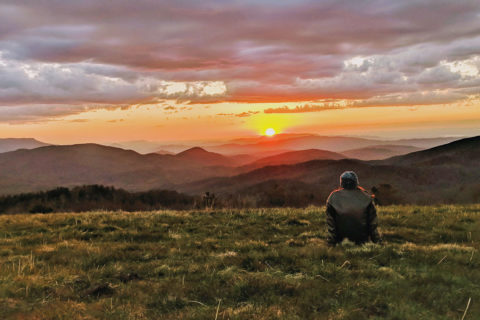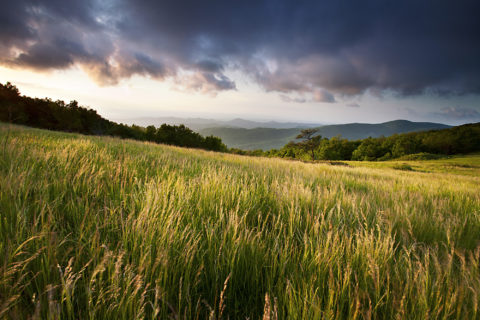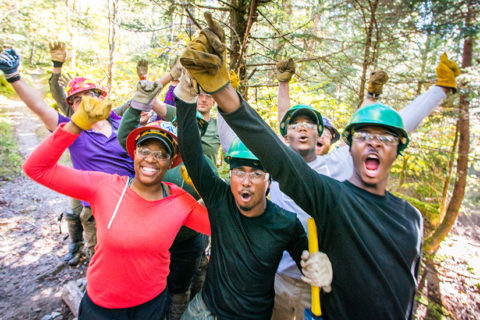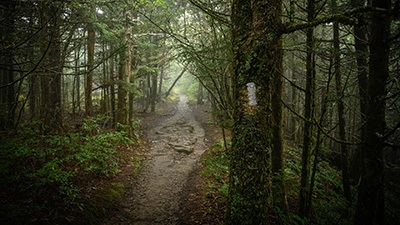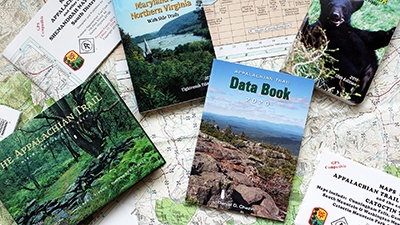By Daniel Anthony Howe
The A.T. in Its Second Century
October 22, 2021
What does the Appalachian Trail mean to the East, to the country, and to the world in the next century of its existence? The experience of the first 100 years sets us up to move toward a new vision — a truly regional ethic of conservation, economic health, stewardship of the natural world, and fellowship among the broad and diverse array of humanity surrounding the Appalachian Mountains.
Benton MacKaye’s 1921 vision was a public declaration of a grand idea, an important leap of faith at that moment in history, and, most importantly, a call to action. The country was emerging from many challenges, including its involvement for the first time in a major foreign war, as well as rapid urbanization and expansion of the nation’s cities in the wake of the Industrial Revolution. And, much as it is today, society was challenged by income inequality, a global pandemic in 1918, racial conflict, and a large influx of immigrants altering the ethnic and cultural landscape of the country. At the same time, the population in rural America was in decline as more sought work in cities, a trend that continues today. MacKaye, a keen student of the social impact of urbanization, looked ahead to a time when the expansion and encroachment of the built environment upon the existing natural landscape would push us all further and further from a life-sustaining connection to nature, and, in doing so, threaten the very existence of the forests and fields that so defined the wild lands in the East he experienced as a child.
He was not alone. Progressive-era reformers had been at work since before the Civil War to introduce the concept of the protection of and access to public lands — starting with Frederick Law Olmsted, Sr., the original landscape architect and designer of Central Park in New York. That public lands should exist at all was then a radical idea. Olmsted saw the establishment of public lands as more than just an effort to preserve or replicate nature. He called Central Park “a democratic development of the highest significance” and “the locale of class reconciliation,” by which he meant a place where both the wealthy and the working poor of New York could have equal access and share the experience of nature across the socioeconomic gulf that was typical of the city surrounding the park. In MacKaye’s time, efforts had been made to preserve lands in the public realm mostly in the West, through the preservation of the first national parks and national monuments, and the establishment of the U.S. Forest Service in 1905 and National Park Service in 1916 to manage these preserves. But in the East, even efforts to set aside forest preserves for managed silviculture were lagging.
MacKaye’s idea of an Appalachian Trail was a powerful one. He argued that the Trail would act as a spine and the lands surrounding it would provide connective tissue, knitting the Appalachian region to the nearest major population centers. It would also link up the work previously done regionally by numbers of hiking clubs and outdoor enthusiasts. The efforts of these clubs to make the mountain landscapes of the East accessible to urban dwellers date back into the 19th Century. A continuous Trail was a clear vision, something that was ambitious but within the realm of possibility, and it captured the imagination of thousands.
But, like Olmsted’s, MacKaye’s concept was broader than a footpath. He envisioned an experience, a way to live one’s life as part of this landscape, a counterpoint to the gritty, frenetic reality of urban living. MacKaye proposed a series of communities be created within the Appalachian mountain “realm,” linked by the Trail, building a sustainable economy through stewardship of the surrounding natural resources and by embracing the burgeoning national interest in outdoor recreation.
Inspired by this vision, five generations of Trail doers and dreamers, mostly volunteers, have taken MacKaye’s big idea and made it what is now, truly the “People’s Trail.” Designated permanently as a unit of the National Park Service through the National Trails System Act in 1968, this simple footpath is now a reality, continuously protected through fourteen states from Springer Mountain to Katahdin. On the 100th anniversary of this grand idea, a celebration is in order.
But, when we consider our progress against MacKaye’s original vision, there is much yet to do. Consider MacKaye’s vision of a broader “realm,” a linked landscape of sustainable communities, a protected experience of (not just a footpath through) the Appalachian highlands. Consider MacKaye’s idea of a sustainable ecology of limitless views and priceless natural systems and species, particularly in this time of dramatically changing climate. And, consider that the faces of those who know of the Trail and seek it out, those who volunteer to keep it open and protected, and those who support it financially and advocate for it, are very much alike and represent only a small fraction of the broadly diverse community of Americans that surrounds the Trail. Consider all these things, and it is clear: There is much yet to do.
When Benton MacKaye proposed “An Appalachian Trail: A Project in Regional Planning” a century ago, oddsmakers would likely have bet against it ever becoming reality. It took a vision of a better way of living with the landscape that inspired so many to do so much to build the Trail. We live in a very different time, with new and perhaps greater challenges ahead of us. And yet this birthday compels us to do what MacKaye did — look ahead into the second century and craft a vision that will drive us forward and make the lands the Trail traverses, not only a healthy and fully protected landscape, but also “a democratic development of the highest significance” in the 21st Century, protected forever for all to enjoy.
Broadening the Vision: Trail + People + Landscape
“Damn it, Benton, the trouble with you is you’re twenty years ahead of your time,” complained a friend of MacKaye after fielding an evening’s worth of his ineffable forward-looking optimism. So must we be similarly ahead of our time in seeing beyond the immediate horizon to a future where the Trail becomes more than the footpath that the first century’s effort made manifest. A vision for the second century of the A.T. must embrace the idea that the relationship between our humanness and the natural world around us is the reason for the Trail and the key to our survival as a culture and a species on Earth. The Trail does not exist but in the context of our perception of it, our work to build and preserve it, and our human experience of it and its surrounding landscape.
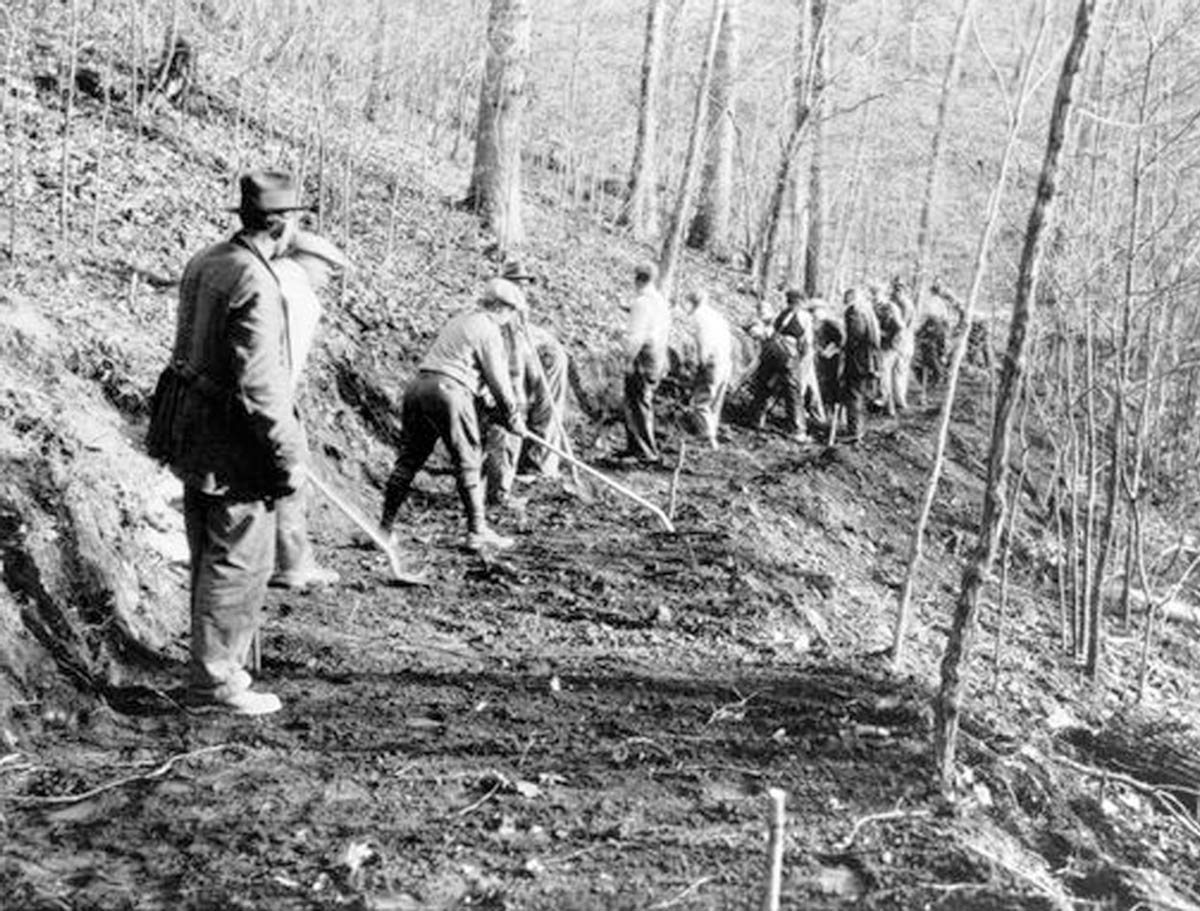
A Civilian Conservation Corps crew cuts a new treadway for the Appalachian Trail in Shenandoah National Park during the Great Depression. Photo from Creative Commons/Wikipedia
Three key values about the Trail help to frame our vision as we look forward:
The Power of Beauty
The experience of beauty, particularly the beauty of the natural world, is universal. It is the rare person who is not awed by the complexity, richness, and spectacle of the world in its natural state. Particularly, we Americans define much of our uniqueness compared to other lands across the globe by celebrating our startlingly beautiful landscapes, from western mesas to wide rivers, stark deserts, and dark forests. First captured by the great landscape painters of the 19th Century — Thomas Cole, Albert Bierstadt, Winslow Homer — we have throughout our national history sought this counterpoint as the world around us began to turn to hardscape, smoke, and noise. Our desire for access to natural beauty inspired the creation of the first gardens and the first public parks and is captured in window boxes as well as in wilderness, in music, and in art. In today’s fractious and rapidly urbanizing world, where daily we are faced with seemingly intractable problems to surmount, access to beauty becomes an ever more acute need, bringing us together across ethnicities and ideologies and inspiring us toward the hope that we can overcome the many things that so separate us. This perspective, this relief, this healing comes not just from dramatic vistas from ridgetops but also from clear water flowing over a rocky creek bed, from a single wildflower, or from the sound of a birdcall high in a forest canopy. The corridor of forests and fields linked along the East by the Appalachian Trail is already the largest and longest continuously protected open space in the United States and provides access to this beauty for millions. In the next 100 years, our challenge is to expand the protected lands that encompass the beauty of the Appalachian region around the Trail and the flora and fauna within it, but also to offer wider access in creative ways to the healing inspiration that comes from beauty as experienced on the Appalachian Trail.
Our Line of Defense Against Climate Change
The reality of climate change is upon us, and the implications for systems that support our very lives are dramatic. The next hundred years will determine just how resilient our broader ecosystem, and our own human species, are to changes that will affect us every day. Access to fresh water, clean air, and adequate food supplies for millions across the globe is threatened by changing rainfall and temperatures.

View from Charlies Bunion – Great Smoky Mountains National Park Photo by Nicollette Legac
The Appalachian region is the best hope for climate mitigation in the East. The headwaters of most watersheds that provide fresh water to urban areas across the entire East begin in the high country of the Appalachians. Healthy, intact, and connected forests are a bulwark against devastating wildfires and act to slow floodwaters in times of extreme weather. Those forests also protect wildlife ecology by providing migration routes along the Appalachian chain of mountains and through preservation of natural food sources and habitats available in the varied landscapes along the Trail — balds and bogs as well as woodlands — and by the resistance to disease and exotic invasive species that results from a diverse interrelationship of many species. The Trail is the spine of this contiguous system of wild lands, forests, waterways and unique geology that provides both climate solutions and resilience against the impacts of climate change. In the next 100 years, our challenge is to use the best science and careful management to understand the complexities of this natural rampart against climate change. Through the actions of both scientists and volunteers, we must protect this unique 2,000-plus-mile climate corridor and use the Trail and its surrounding landscape as a laboratory for a sustainable response to a changing world.
An Unparalleled Recreation Resource
Within a day’s drive of nearly two-thirds of the United States’ population, the Appalachian Trail is a world-renowned recreation asset for millions, providing a link to and between national parks, national forests, state parks and forests, national recreation areas, and wildlife preserves from Baxter State Park in Maine to Amicalola Falls in Georgia. As the population of this region continues to grow and diversify, especially in the Sunbelt states of the Southeast, the importance of this recreational wonderland to individuals and families and to the communities surrounding the Trail will continue to expand.
Access is often a challenge. For people with few resources in terms of time, money, and transport, the Trail is still infinitely remote. And, recreation means different things to people of varied cultural backgrounds. A wilderness epiphany for one is a scary reminder of vulnerability for another. Some seek solitude while others revel in a shared experience of beauty. The twin challenges of protection of the Trail footpath and experience that we know today, along with expansion of access to the Trail by new, more urban, and more diverse populations sets up a delicate balance and demands careful management and new partnerships. MacKaye’s original vision articulated the footpath as a framework for the establishment of a series of rural communities in the Appalachian region supported primarily by an expanded recreation-based economy. It is not newly built communities as MacKaye originally envisioned, but existing historical communities on and surrounding the Trail that are becoming key partners in the development of a sustainable rural economy surrounding the Trail corridor, based on access to the outdoors. In the next 100 years, our challenge will be to continue to sustainably expand access to the Trail and its experience to more and different populations of Trail users and supporters and to help make viable MacKaye’s original idea of Appalachian communities that provide a sustainable economic alternative to city living. This will be accomplished by supporting the economic life of those communities and by enlisting them as partners in providing off-Trail services, partners in the management of the increasing flow of visitors, partners in providing education about the environmental value of the Appalachian region and the cultural history of its people, and partners in conservation of the lands and waters that draw recreational visitors to these mountains.
A vision for the second century of the A.T. must embrace the idea that the relationship between our Humanness and the natural world around us is the reason for the Trail and the key to our survival as a culture and a species on earth. The Trail does not exist but in the context of our perception of it, our work to build and preserve it, and our human experience of it and its surrounding landscape.
A hundred-year vision, starting now
Large landscapes preserved: In its 2015 Centennial strategic plan, “A Call to Action,” the National Park Service noted the need to begin to think beyond the boundaries of the parks and to engage adjacent communities, indigenous communities, ranching and farming interests, and local governments in the mission and goals of its protected lands as partners. Ecosystems, views, watersheds, and wildlife habitats respect no artificial boundary, and the park service noted that the experience within the boundaries of the park is inexorably linked to the community and landscape outside as well. The Appalachian Trail represents a very narrowly protected corridor with an extensive and often threatened boundary. The essence of the Trail experience is not only the Trail itself and the narrowly protected corridor within which it exists, but the views of farms and settled rural landscapes that are visible from its ridges, the vast woodlands, and the habitats in those forests that support some of the most diverse ecosystems in the world. These extended landscapes are mostly privately owned, including agriculture, small towns, historic places that tell the important story of the culture of the Appalachian mountain region, managed woodlands and, yes, expanding suburban growth, energy infrastructure, and mining. In the second century of the A.T., many partners beyond federal and state agencies must work with state and local communities to protect those lands and landscapes beyond the Trail itself with the goal of preserving a “realm,” not just a footpath. The tools of this large landscape conservation effort will involve not just traditional purchase of conservation lands and easements, but cooperation with communities and Indigenous tribes in managing land use and protecting key natural systems and spectacular views that draw visitors to support local economies.
A nation of Trail stewards: In the wake of MacKaye’s idea a century ago, groups of volunteers — lawyers, mechanics, educators, clerks and laborers, men and women — in partnership with federal and state workers hacked their way across the ridgetops and through dense forest to build the original Trail. Four generations later, the Appalachian Trail remains unique — a public landscape still cared for primarily by volunteers, managed by a one-of-a kind public-private cooperative management model. As more and more of us are drawn to this Trail, we envision a time when all who come to this place embrace an ethic of respect and care for the footpath and the natural and cultural landscape that surrounds it through education and volunteerism. As we attempt to strike a balance between the desire to make the Trail more accessible to more people and the need to care for the increasingly threatened ecology of the landscape and the Trail itself, our vision is an ever-widening circle of Trail stewards who accept mutual ownership of this special resource — who volunteer their time to protect it, who advocate for its importance, who donate their own time and resources to ensure its continued existence, who come and experience the Trail and leave it better than they found it. The Appalachian Trail, although envisioned and championed by bold thinkers, was built by people like you and me. Our vision is that this remains a landscape entrusted to the people, cared for by a volunteer army of supporters and stewards, and open to a nation of visitors who understand and respect the values that the Trail represents.
The Trail needs a new, and more broad-based generation of supporters, volunteers, and advocates to ensure its existence as the signature recreation resource in the East into the future.
A Trail that supports varying recreation experiences sustainably: In the Organic Act of 1916, the National Park Service was established to care for the new national parks and “to conserve the scenery and the natural and historic objects and the wildlife therein and to provide for the enjoyment of the same in such manner and by such means as will leave them unimpaired for the enjoyment of future generations.” Today, the Park Service struggles with this now-difficult mission to preserve the unique resources of the national parks unimpaired for future generations, while still providing the opportunity for the people to enjoy them today. What once was a few fortunate travelers arriving by train to view the wonders of Yosemite or Yellowstone has become more than 237 million visits each year, by people seeking a wide variety of experience, from wilderness solitude to festival celebration. Similarly, the Appalachian Trail experiences a year-over-year increase in both long-distance hiking and day-use visitation. As more people from more places with more widely divergent backgrounds discover the Trail, and as the distance between metropolitan populations and the Appalachian region shrinks, our thinking about what “the A.T. experience” means must necessarily expand. It will no longer be sufficient to assume that the solitary long-distance backpacker represents the Trail’s only desired experience. This more than 2,000-mile corridor must provide not only that opportunity but must also accommodate a new population of visitors who might seek a more guided experience, or a shorter one, or a more accessible one to allow people who are challenged physically to join the A.T. community. The implications of this are dramatic for the Trail and are not unlike the challenges faced by the National Park Service in its efforts to live up to the Organic Act. Encouraging more people to be on the Trail puts at risk the natural systems that make up what draws them here. Limiting such use flies in the face of a century-long ethic of self-sufficient woodland experience and open access. The Trail needs a new and more broad-based generation of supporters, volunteers, and advocates to ensure its existence as the signature recreational resource in the East into the future.
A bulwark against climate change: Scientists have noted that climate-resilient sites are those where nature’s natural resilience is highest — places with a broad diversity of microclimates within a landscape of varying topography, hydrology, and diversity of species: the very definition of the Appalachian region of the eastern U.S. The ability of species to migrate both longitudinally (along a corridor) and vertically (up or down in elevation) allows a much greater chance of surviving such times of rapidly changing climatic conditions. And, our survival is intimately tied to this diversity of species, protection of drinking-water resources, rivers, streams, and soils that support agriculture and the forests that clean the very air we breathe. The A.T. corridor is uniquely positioned to be a demonstration site for cooperative protection of a critical climate corridor, stretching across fourteen states and countless ecosystems, with the goal of preserving a relatively stable ecology in the eastern mountains. This is the largest and longest continuous protected open space in the United States. It is our challenge to support legislation to declare the A.T. corridor as a designated climate corridor and bring resources to bear for research and mitigation efforts to protect our natural treasures for future generations.

The Appalachian Trail today connects with many trails, including the Long Trail in Vermont. The summit of Bromley Mountain is about the halfway point of their 106-mile coalignment. The Long Trail’s pioneers were MacKaye contemporaries, who often imagined extending it all the way to the southern Appalachians. MacKaye always favored the A.T. as the backbone of a network of trails. Photo by Christopher D’Ambrosio
Trailside communities that are essential partners in supporting the Trail experience: For some time, a type of economic Darwinism has driven decision-making about rural economies. In the face of competition with the big metros or with overseas industries, rural towns were expected to adapt or simply shrivel. And, for much of the past 50 years, communities in the Appalachian region have lost population and jobs as industry moved elsewhere. Yet, MacKaye in his prescient way saw the intangible benefits of small-town living, even as the metropolitan cities of the East began their earnest expansion, and proposed a utopian series of resource-based or recreation-based communities linked by a Trail. As we look toward the future, the A.T. community must support a new generation of urban dwellers who are rediscovering small “gateway” communities along the Trail, with a new appreciation of their closeness to the beauty of nature and intimate sense of small-town life. Recreation-based economies are driving new life into what has been a declining economic region. Our challenge is to continue to build community with towns and regions in the Appalachians — to establish partnerships with newly rejuvenated Trail towns to engage them as conservation partners and stewards of the outdoor recreation economy and to encourage them to be educators about Leave No Trace ethics and provide services off-Trail to new visitors and stewards in our ever-broadening circle of A.T. enthusiasts.
The story of people and place woven into the experience of the Trail: The A.T. traverses a landscape of woodlands, streams, and fields, but also a human landscape made up of successive generations of settlement in the mountains, tainted by colonization, wars, and tragedy, yet enriched by heroism, determination, and a unique mountain sense of humor. The building and abandonment of towns, the artifacts and literature left behind, and the “high, lonesome sound” of mountain life immortalized in music, dance, and art mark the journey along the A.T. In addition to the Trail’s role in supporting a personal odyssey in the woods for many, it also forms a journey through time told through the stories of peoples whose lives were entwined with the mountains of the East. In the first 100 years, our attention was focused on making accessible to visitors to the Trail a personal connection to the beauty of nature. In our second century, the richness of the Appalachian story needs to be woven more tightly into the tapestry of the A.T. experience. As more people move through this landscape, opportunities to tell the broader story of the mountains need to expand through interpretation and storytelling, partnerships with tribes and communities in art and music, and education programs for young people coming to this region for the first time.
A network of connecting and parallel trails: Just as the Trail provides connective tissue to knit the landscapes of the eastern mountains into an experiential whole, connective trails like the Overmountain Victory Trail and the Long Trail link the people, stories, and landscapes of the foothills and adjacent mountain ranges and settlements to the high ridge. In MacKaye’s original concept, rail, trail, and roadway connectors made the A.T. accessible to all. In the wake of the National Trails Systems Act, numerous connections have been made between the A.T. and other important trails, such as the Highlands Trail, the Bartram Trail, the Allegheny Trail, and the C&O Canal. And, as the number of visitors increases on the A.T., the importance of parallel trails expands, such as the Great Eastern Trail, the Benton MacKaye Trail, and the Foothills Trail, as well as the East Coast Greenway. Management of the critical resources of the high country along the Appalachian Trail is a multifaceted challenge in the second century. Bringing new constituencies to the Trail via new rail and connecting trail opportunities opens the A.T. experience up to more, and more diverse, visitors. Thinking of the A.T. as part of a network of trails, intersecting and parallel, and planning for more connections and more opportunities to experience the Appalachian region on parallel trails can help divert crowds in the most critical places along the A.T. to other opportunities. Cooperating together as a family of footpaths will help to build more partnerships and more constituencies for advocacy toward public land protection and support rural economies and protected woodland experiences in the East.
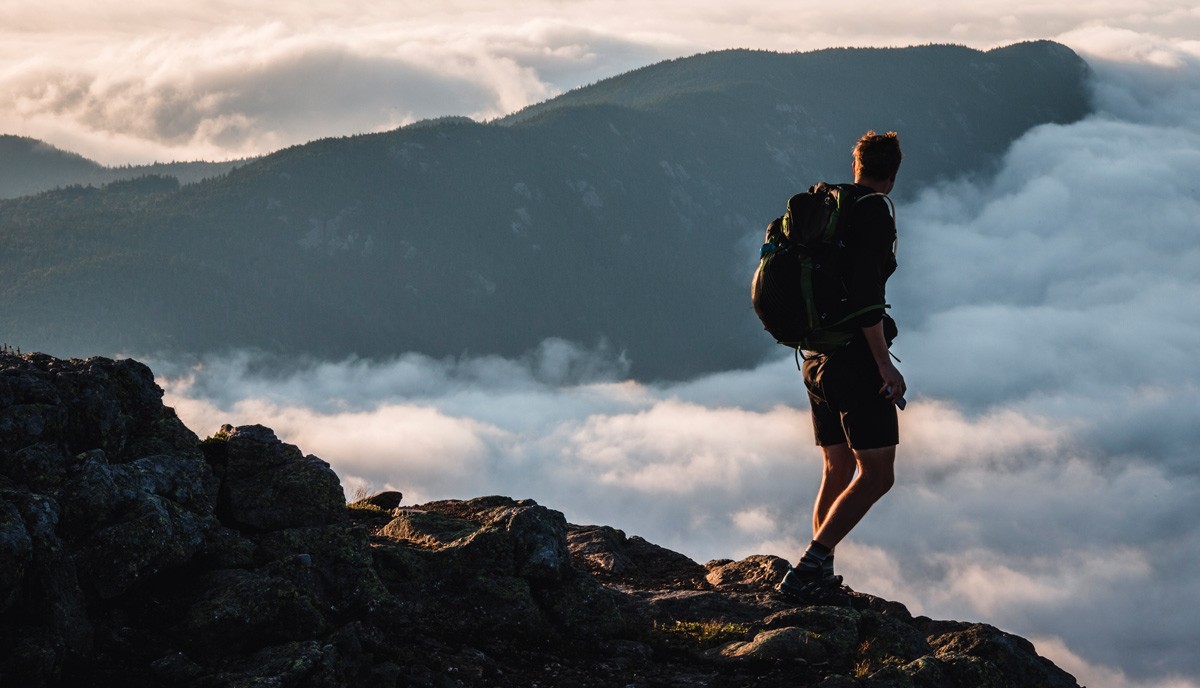
A.T. – Bigelow Mountain, Maine. Photo by Chris Bennett
The Second Century begins with a new call to action
Benton MacKaye changed my life. He did so by inspiring thousands to grasp onto his idea and make it real, and, in doing so, they created the stage set for my transformation as a person. My time on the A.T., among a community of others in the midst of their own odysseys, opened my eyes to my place in a larger world of people very different from me, a world of seemingly limitless forests that I barely knew existed, a world where we are all connected — just as the Trail itself connects ecosystems, and states, and cultures. I am a better person, leading a richer life because of the lessons I learned on the A.T. about the interrelationship of living things, my own ability to exceed what I thought were my limitations, and what is really important out there beyond all the noise. My question to you is this: Whose life will your actions, your contributions, transform? When we revisit the Appalachian Trail 100 years from now, will you be one of the thousands (maybe millions) to thank for protecting MacKaye’s “realm” beyond the footpath even as urbanization surrounds it? Will you be instrumental in helping breathe life into a small Appalachian community, or perhaps be among those telling the story of our history and of the people who populated the mountains before the Trail existed? Will you help make it possible for this extraordinary Trail, its land, its plants and animals, and its people to weather the anticipated, unprecedented changes in rainfall and temperature we expect over the next 100 years? And will you, through your own actions, make it possible for even one small child, who may not look like you and who may otherwise have never known any landscape except that of asphalt and chain link fence, find themselves transformed on a high ridge beneath the tall oaks, as I have been so lucky to be?
Our challenge in the second century is not as clear-cut as “build the footpath” might have been for those who mobilized in the wake of MacKaye’s inspirational article. Now, we are asked to expand our scope of protection to the broader landscape beyond the Trail, to embrace the idea of rural, sustainable, recreation-based communities that he originally envisioned and to manage a climate challenge without a roadmap for doing so. But, we can, because this is the People’s Trail, and, if we set our minds to it, we the people can bring this new vision to reality by working together as partners. In the 21st Century, Benton MacKaye’s voice still calls us to action. It will be you — your voice, your work, your gifts — who will answer that call.
 Daniel A. Howe, like Benton MacKaye, is a planner. Dan is a Fellow in the American Society of Landscape Architects and a member of the American Institute of Certified Planners. He is currently Assistant Professor of the Practice in the Department of Landscape Architecture and Environmental Planning at North Carolina State University in Raleigh. His thru-hike of the Appalachian Trail inspired his career choice. Dan serves the ATC and the Trail community with his largest single charitable contribution every year and volunteers as a member of the Board of Directors of the ATC and as Chair of the Stewardship Council. He is also a member of four Trail clubs in Virginia and North Carolina and wishes he had more time to join them in Trail-maintenance projects, but he’s still happy to contribute his member dues toward the great work the clubs do to keep the Trail accessible for us all.
Daniel A. Howe, like Benton MacKaye, is a planner. Dan is a Fellow in the American Society of Landscape Architects and a member of the American Institute of Certified Planners. He is currently Assistant Professor of the Practice in the Department of Landscape Architecture and Environmental Planning at North Carolina State University in Raleigh. His thru-hike of the Appalachian Trail inspired his career choice. Dan serves the ATC and the Trail community with his largest single charitable contribution every year and volunteers as a member of the Board of Directors of the ATC and as Chair of the Stewardship Council. He is also a member of four Trail clubs in Virginia and North Carolina and wishes he had more time to join them in Trail-maintenance projects, but he’s still happy to contribute his member dues toward the great work the clubs do to keep the Trail accessible for us all.
This article was originally published in our Fall 2021 issue of A.T. Journeys, the official membership magazine of the Appalachian Trail Conservancy.

